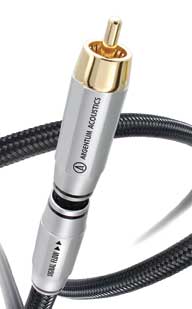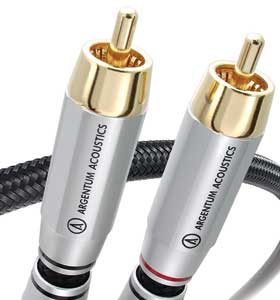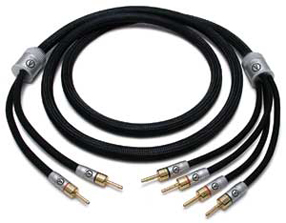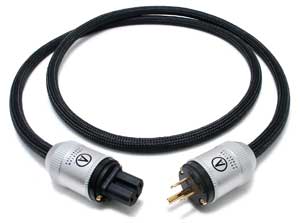 |
|||||||
|
|
|
|
|
|
|
|
|
My samples included the bi-wire speaker cables, two pairs of interconnects and digital cable, which I used with a DA converter and the source component. All cables sport a unique black woven jacket and are beautifully terminated with custom-made connectors. The Aureus speaker cable and the Proteus-12 power cord are about 20mm thick, while the Mythos interconnects and the Argento digital cables are about 10mm thick. The cables are flexible enough for easy placement and with their classic black jackets make them rather unobtrusive, thus minimally offensive to the hard to please. The Sound In order to see what I had to say back in 1996, I checked the pertaining issue Vol. 9, No. 2 of The Inner Ear Report magazine (now shuttered). Upon reading my own review, I recalled some of the cables sonic characteristics which, at the time, was right up there with some of the industry’s more expensive cables. It outperformed the likes of Monstercable, Straightwire and Wireworld, but also held its own when compared with top-of-the-line van den Hul, Monster’s Sigma and Audioquest. The new Argentum, however, surpasses all performance characteristics of the older version, which, I believe, can be attributed to design and material advances. What I like about it the most is its sonic firmness and resolution. Bass reaches deeply into the low note registers of instruments performing in that region; and it does so without leaving behind unresolved fundamentals, or obscuring important harmonics. Indeed, the second most liked item of important performance parameters is the Argentum’s potential to pry out harmonics throughout the entire frequency range. It is relatively easy to hear the different tonal qualities of a trumpet and a cornet for example; to enjoy the sound and hear the sonic makeup of various pianos, such as a Yamaha, a Steinway, a Baldwin or a Boesendorfer Imperial Grand. It is those subtle harmonics which allows us to hear these differences and, as the saying goes “the more, the better” when it comes to contributing distinction to the entire audio set-up.  Female vocals are exceptionally clear, real enough to imagine the vocalist
in the listening room. Tenors and baritones turned out to be almost as impressive,
especially noticeable when used with my in-house high-end components. Female vocals are exceptionally clear, real enough to imagine the vocalist
in the listening room. Tenors and baritones turned out to be almost as impressive,
especially noticeable when used with my in-house high-end components. Resolution and harmonics are very important to identify and complete a musical score, but are not enough to enjoy unless a few more elements are in place. Well, let me assure you that there are more. To ascertain the Argentum’s sonic make-up I used three different auditioning systems and, though different relative to high-fidelity accomplishment, the signature of the cables consistently emerged. With the high-end setup — the Wyetech Labs Ruby monoblock amplifiers and matching preamplifier — I achieved the best results. This system had been connected with top-of-the-line, much higher-priced cables I have in-house at all times, and when I replaced them with the Argentum speaker cables and interconnects my respect for them went up dramatically. Not only did the cables match elements such as tonal balance, imaging and the essential musical quality, they also introduced spatial effects and appropriate focus on instruments and voices. I would be looking for these refinements in high-end cables and was not expecting the high degree of sonic accomplishment with Argentum cables, priced at two-thirds less than my existing cables. In a lower-priced system — a Magnum MD 208 receiver, a pair of Ethera Vitae speakers and a BelCanto CD player, the Argentum cables’ sonic attributes were basically identical to aforementioned system. The BelCanto S3001 integrated amplifier, with the BelCanto CD player as source component rendered another admirable performance when I used the Argentum interconnects and speaker cables. In fact, this medium-priced system leaned towards the high-end classification than the system price would suggest. The cables complemented this system by easily reproducing dynamics and harmonics while maintaining tonal balance throughout the frequency range. As with the other system configurations, resolution throughout the audible extent, but most appreciable in the bass region, matched my highly priced in-house cables’ performance. I tested the interconnects — a 25-foot pair and a one-meter pair — and found that their sound was identical, quite organic and free of rough edges. Still, when hard sound was called for in musical arrangements (trumpets, percussion, etc.) the cable faithfully reproduced the dynamics, but did not modify the soft sound of a voice, for example. This tells me that harmonics are undiminished to finish the musical impression. The shorter interconnects worked well with the CD player and the tuner in my set-up. The longer ones, mainly used between amplifier and preamplifier in the classic system configuration, provided a natural link that didn’t diminish or enhance the components to which it was connected. That can be a good thing, provided the equipment is of good quality. The speaker cable Every cable I have auditioned has a sonic signature — and the Aureus-2BW bi-wire speaker cable isn’t an exception. Its sonic disposition is made up of absolute clarity, razor-sharp resolution and compatibility with different components. My tests established that the Argentums’ high degree of sonic neutrality provides a transparent window for auditioning components to which they are connected. Ideally suited for reviewers and audiophiles who audition a lot of equipment. Synopsis and Commentary There seems to be no limit when it comes to the price of cables. I have followed the cable companies’ developments for over twenty years, observed their progress and appreciated their contribution to the consumer electronics industry. Although I have been in the business since lamp-cord speaker wire and the give-away interconnects, I became one of the first believers regarding connecting methods and sonic improvements gained by good cables. At first, cables were a tweak, accessories not an absolutely necessity. Soon, however, I saw/heard startling improvements in materials and technical disciplines which made prices soar to an all-time high in the high-end categories and become outright cheap in the low-end. Thus, I began to regard the more expensive cables currently on the market as components when used in high-end applications. Though not always an indicator, high price does lead us to cable manufacturers who made a science out of transferring electronic or musical signal, and it’s almost bewildering to see cables priced at up to five-thousand bucks ($5K) a foot. The Argentum series has been designed to conform to all-important technical guidelines employed by high-end manufacturers. However, a great deal of money was saved and research and development costs were cut significantly, because the parent company, Ultralink Products, Inc. has a standing R&D program for its Ultralink and XLO products. Therefore, Argentum cables come in relatively inexpensive, while they give some of their expensive competitors a run for the money, sometimes winning, sometimes matching the performance of cables priced as much as three times higher. Finally, I’d like to clarify my comment at the beginning of this review where I mentioned that the Argentum cables were designed to fit between the Ultralink and the XLO cables. I wish to add here that they will fit between many of the very highly priced and medium-priced brands out there in consumer land, and provide high-end signal transfer for serious audiophiles and music lovers.
|
|
| News | Reviews | Commentary | Marketplace | Contact Us | Home |


